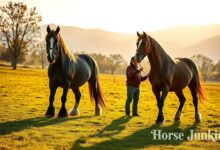Understanding Roan Horse Coat Colors & Patterns
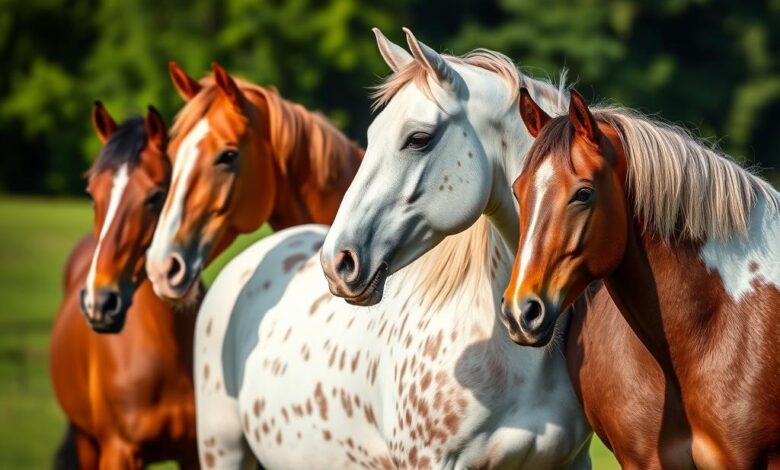
Have you ever wondered why some horses seem to defy the typical aging process of coat colors? They keep their striking appearance throughout their lives. This is especially true for roan horses.
Roan horses have a unique coat color. It’s a mix of colored and white hairs. This makes them stand out from other breeds. Unlike other coat colors, roan horses are born with their distinct color. It stays the same as they age.
In this article, we’ll explore the fascinating world of roan horses. We’ll look into their genetics and the care they need. Every enthusiast should know these important details.
Key Takeaways
- Roan horses maintain their unique coat colors from birth, unlike many other breeds.
- The roan gene is dominant and influences the appearance of coat colors in various breeds.
- Prominent breeds with true roan coats include Quarter Horses and Thoroughbreds.
- Some roan horses may be mistakenly identified as other colors due to seasonal changes and coat variations.
- Genetic testing for the roan gene is essential for breeders to understand the inheritance patterns.
- Roan horses may exhibit unique features like “corn spots” and reverse dappling.
What is a Roan Horse?
Roan horses are known for their unique look. They have a coat color mix of white and colored hairs. This mix usually leaves the horse’s head, mane, tail, and legs in a solid color.
Understanding roan horses starts with knowing their coat color traits. These traits are important for their genetics.
Definition of Roan Coat
The roan coat has white and colored hairs evenly spread over the horse’s body. This gene works with colors like sorrel, bay, and black. It creates three main roan colors: red, bay, and blue.
The roan gene is simple and dominant. This means one parent must have it for the trait to be passed on.
Historical Context of Roan Horses
Roan horses have played a big role in horse history. They were mentioned by King Richard II of England and in William Shakespeare’s works. The American Quarter Horse breed has many roan lines, with famous horses like Red Man and Blue Valentine.
In 2007, about 7% of American Quarter Horses were roan. They are found in many breeds, like Percherons, Belgians, and Paints. This shows their lasting appeal and beauty.
Types of Roan Coat Colors
Roan horses show off a wide range of coat colors. Each color is a mix of base hues and white hairs, making for stunning patterns. These variations highlight the beauty and diversity of roan horses.
Red Roan
Red roan horses have a vibrant mix of red and white hairs. They were once seen as a type of chestnut. The white hairs are less visible on the head, mane, tail, and legs, showing off the rich red color.
This unique pattern makes red roans stand out in equestrian events.
Blue Roan
Blue roan horses have a black base coat with white hairs, giving them a bluish look. This color pattern is especially beautiful in their mane and tail, which stay black. The mix of colors creates a unique look that catches the eye in any setting.
Strawberry Roan
Strawberry roans have a lighter chestnut color mixed with white hairs. Their soft, warm tones are a favorite among horse lovers. The blend of colors not only defines strawberry roans but also adds to the charm of roan coat colors.
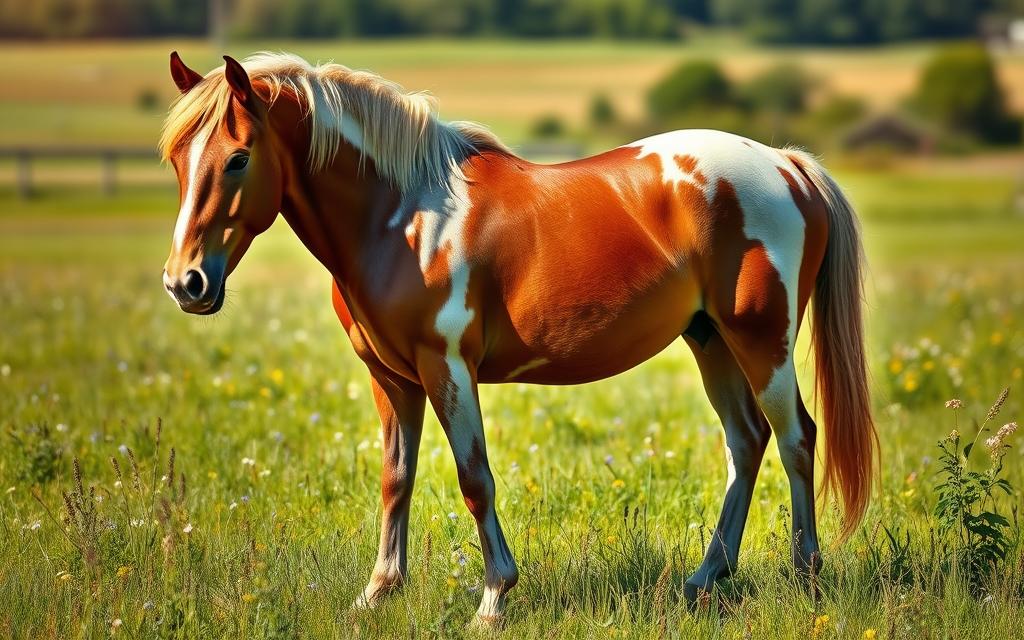
Genetics Behind Roan Patterns
The world of roan horse genetics is full of interesting facts. It helps us understand how the roan pattern is passed down. This knowledge is key for breeders and fans of these horses.
Inheritance of Roan Traits
Roan is an autosomal dominant trait. This means it plays a big role in how roan patterns are inherited. Horses with the N/N genotype don’t show the roan pattern and can’t pass it on.
Horses with the N/Rn genotype have the classic roan pattern. They have a 50% chance of passing this trait to their foals. Those with the Rn/Rn genotype always pass on the roan pattern to their offspring.
Role of the Roan Gene
The roan gene is crucial in roan horse genetics. It changes base coat colors, creating roan shades like blue roan and bay. It’s found in breeds like Quarter Horses and Paints, making these horses even more appealing.
Some theories say homozygous individuals might have reproductive issues. But, Quarter Horses show no such problems. Breeding data shows the roan trend continues, proving these horses’ lasting appeal.

Characteristics of Roan Horses
Roan horses are known for their stunning coat colors and unique traits. These roan horse characteristics make them stand out. We’ll look at their physical traits and their behavior and temperament.
Physical Traits
A roan horse catches your eye with its special coat pattern. It’s a mix of white and colored hairs. This pattern is often matched with solid dark points on their head and legs, showing off the roan horse characteristics.
The most common colors are:
- Red Roan
- Blue Roan
- Bay Roan
The roan gene works with any base coat color. This includes sorrel, chestnut, bay, black, palomino, seal brown, and grulla. True roan horses don’t get lighter with age, unlike gray horses.
Behavior and Temperament
Roan horses can have different behaviors and temperaments. This depends on their breed. For example, Quarter Horses are smart and versatile, making them great for many riding styles. They are often calm, which is why they’re so popular.
On the other hand, Thoroughbreds are known for their energy and competitiveness. This is because of their racing background.
Knowing these roan horse characteristics helps us care for them better. It lets us see their amazing adaptability and beauty.
Caring for a Roan Horse
Caring for a roan horse means knowing its grooming and health needs. As horse owners, we must focus on what keeps our roan horses healthy and happy. Their striking coat needs our attention to stay beautiful.
Grooming Needs
A well-groomed roan horse shows good care and health. Regular grooming keeps the coat clean and the roaning pattern bright. Here are some grooming tips:
- Use gentle horse shampoo during baths to maintain the coat’s vibrancy.
- Brush regularly to prevent matting and to remove loose hairs.
- Pay particular attention to areas around the legs and flanks where solid-colored hairs may be more prominent.
Good grooming not only keeps the coat healthy but also strengthens our bond with them. It’s a chance to check for skin issues or injuries.
Health Considerations
It’s important to watch for health changes in roan horses. They may have special skin and coat health needs. We should look out for any coat color changes, especially with the seasons:
- Watch for any changes that may indicate health issues, such as discoloration or bald spots.
- Maintain a balanced diet with sufficient nutrition to support coat health.
- Schedule regular veterinary checkups to catch and address any potential health issues early on.
By understanding these grooming and health needs, we ensure our roan horses look great and stay healthy for years.
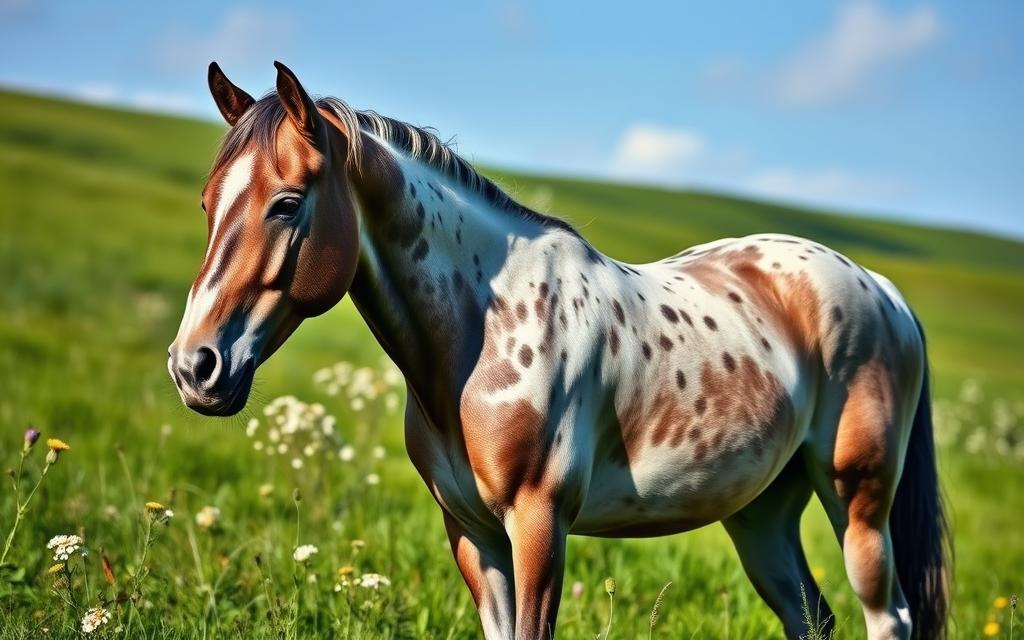
Popular Breeds with Roan Coats
Many horse breeds have beautiful roan coats. These coats make each horse unique. Let’s look at some popular breeds known for their roan coloring.
Quarter Horses
Quarter Horses often have striking roan colors like red and blue. This breed is loved for its versatility. The roan patterns add to the beauty and bond between riders and their horses.
Thoroughbreds
Thoroughbreds sometimes have roan horses. The roan gene is rare in this breed. This makes roan Thoroughbreds extra special.
Appaloosas
Appaloosas have a unique roan pattern that mixes with their famous spots. This creates a breathtaking look. Celebrating Appaloosas helps us appreciate the beauty of roan horses.
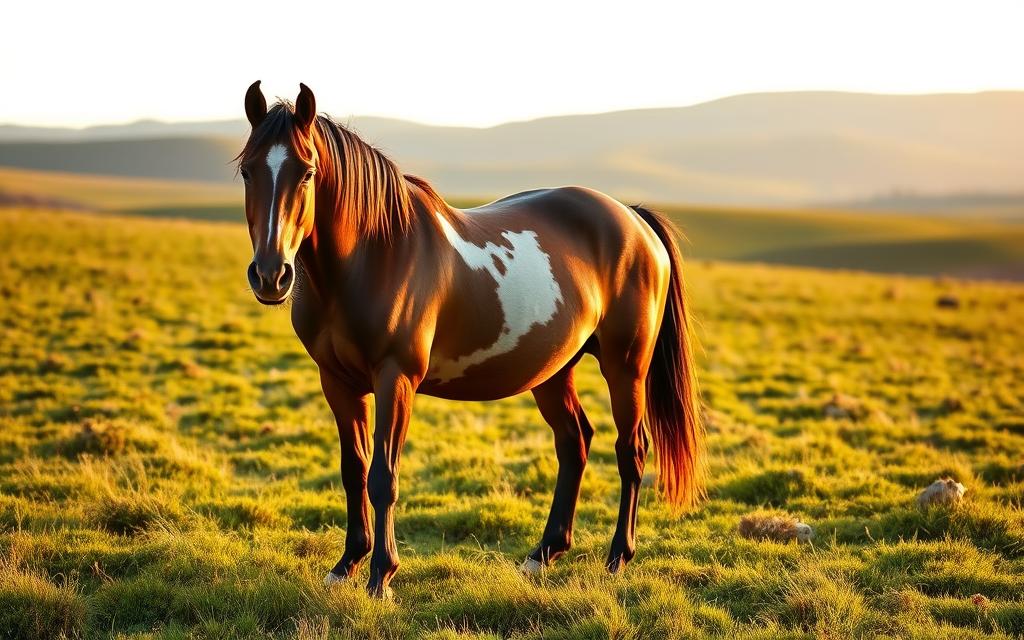
Myths and Misconceptions About Roan Horses
In our journey to understand roan horses, we find many myths. These myths often confuse our view of these beautiful animals. By clearing up these misconceptions, we can truly appreciate the roan horse’s uniqueness. Let’s look at some common myths and the different roan variations.
Common Myths Dispelled
Many think roan horses can come from non-roan breeds. But, the roan gene is dominant. It needs at least one parent with this gene for roan offspring to appear. This genetic rule is key to understanding roan horses.
Some also mix up roan horses with other coat types. This leads to more confusion.
- Roan horses do not lighten with age like gray horses do.
- Only horses with the roan gene can have roan foals. These foals show this unique coloring as they shed their baby coats.
- Some breeds, like Arabian or Suffolk Punch, do not have roan coats.
Understanding Roan Variations
Roan horses are diverse and beautiful. They can be any traditional color, with blue roan being especially striking. This color has a black coat mixed with roan hairs, with dark head and legs.
This color can be mistaken for sabino, which lacks the roan gene.
The roan horse’s special traits make it popular among horse lovers. Each variation adds its own charm. From the blue roan in American Quarter Horses to the exciting possibilities in Mustangs and Appaloosas, understanding these variations deepens our appreciation for roan horses.
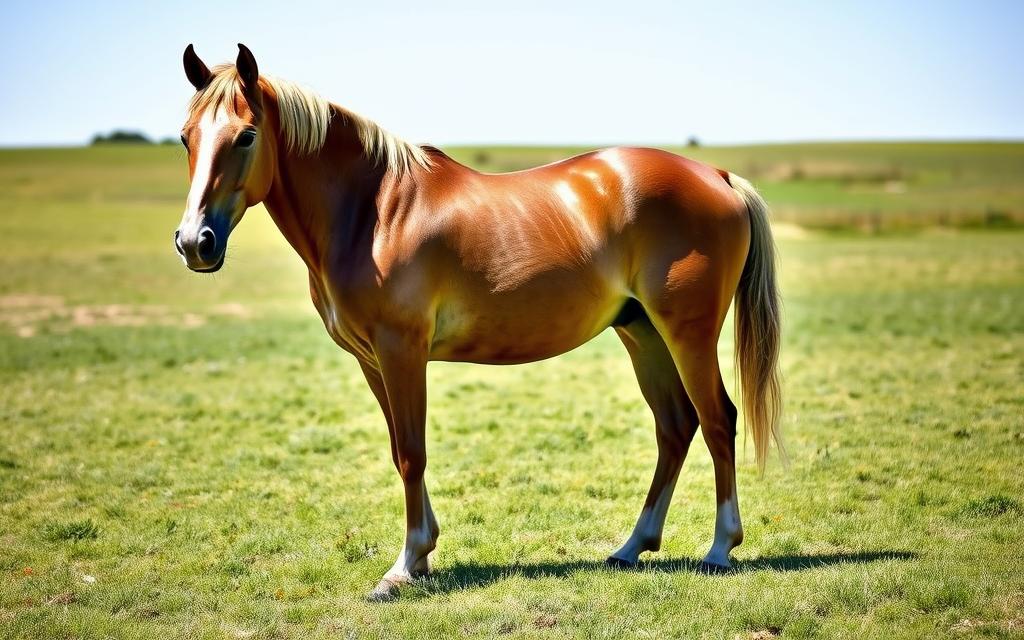
Roan Horses in Popular Culture
Roan horses have caught the eye of many through media. Their unique look and striking colors make them stand out. They are beloved in stories and movies, showing their special charm.
Media Representations
Over the years, roan horses have shown up in many stories and films. The Black Stallion by Walter Farley is a classic, starting in 1941. It has 21 books, inspiring love for horses in readers.
The 1956 film The Ten Commandments had beautiful horses, Nurah and Thebes. The 1976 film The Shootist starred John Wayne and his roan horse, Dollar. These stories and horses bring excitement and depth.
Famous Roan Horses
Famous roan horses add to their cultural impact. For example, Maximus from Disney’s Tangled is loved for his unique look and personality. Real-life horses like Cass Ole from The Young Black Stallion also gain fame.
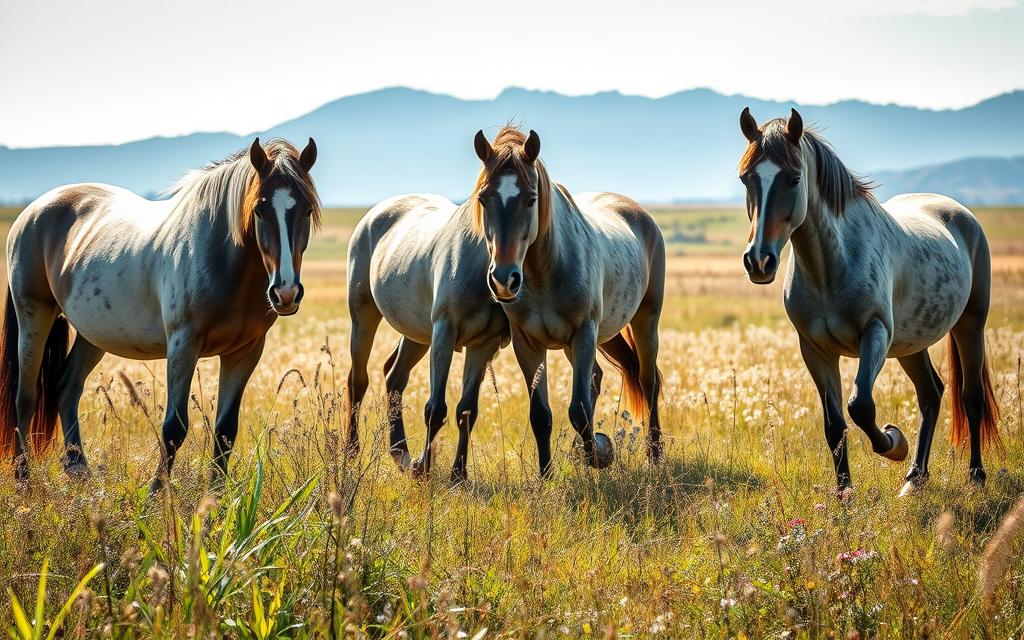
The Role of Roan Horses in Equestrian Sports
Roan horses, especially the blue and bay roan types, are key in equestrian sports. Their special roan horse traits make them stand out. They are not just pretty but also have qualities that fit many sports.
Competitive Advantages
The eye-catching coat colors of roan horses are just one reason they’re loved. Their quickness and ability to respond well give them an edge. Some benefits include:
- Versatility: Roan horses do well in both western and English riding.
- Calm Temperament: Many roan horses are calm, making them good for different riders.
- Strong Athleticism: Their build helps them perform well in events like cutting, dressage, and barrel racing.
Training Considerations
It’s important to know the roan horse traits when training them. Each roan horse needs a special training plan based on their needs and breed traits. Key training points include:
- Foundation Training: Start with building trust and making them responsive.
- Consistent Routines: Regular training keeps their skills and shape up.
- Positive Reinforcement: Use encouragement and rewards to help them learn and engage.
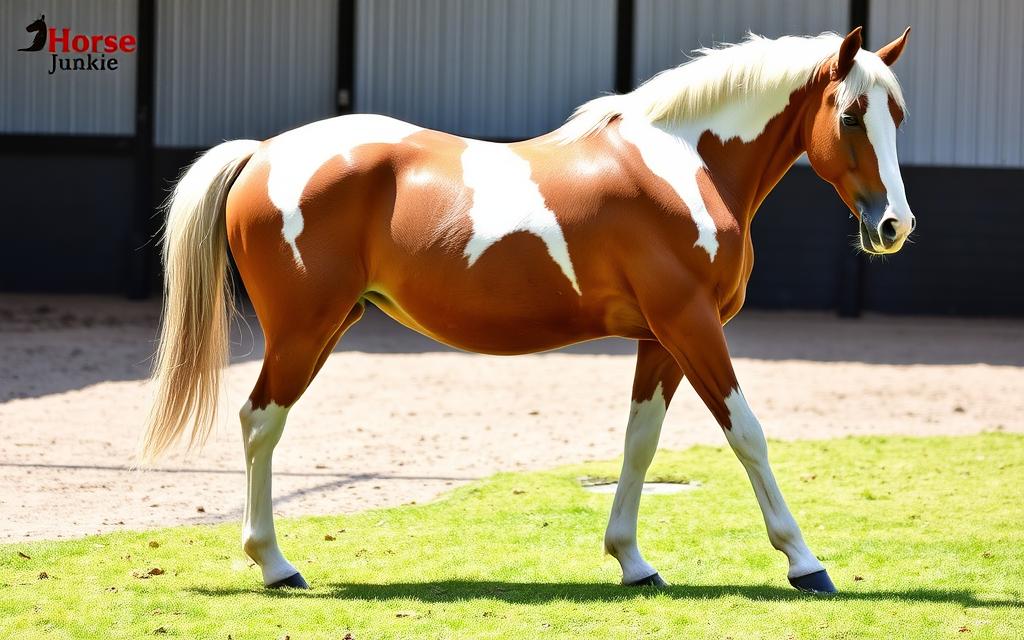
By understanding and using these training tips, we can improve roan horses’ sports performance. Their special qualities, along with proper care and training, make them great partners in equestrian sports.
Recognizing Roan Patterns in Different Light
Roan horses show off their unique coat colors in different lights. Their colors change a lot depending on the setting and the season.
Variability in Coat Color
Roan horses have a mix of colors that change with the seasons. In winter, their coats look darker because of thicker hair. But in summer, their lighter coat shines through more.
We see red roans, blue roans, and strawberry roans, each with its own charm. The roan gene makes sure the colored and white hairs mix well, especially in sunlight. This makes their beauty even more striking.
Effects of Sunlight and Environment
In sunlight, roan horses’ true colors pop out. The contrast between colored and white hairs is breathtaking. It shows off their beauty in a unique way.
But, the environment also affects how we see their roan patterns. Shadows and light can change how we see their coat. When we look closely, we see how lighting can change their roaning features.
How to Determine if a Horse is Roan
Figuring out if a horse is roan can be tricky. It’s all about spotting certain coat traits and comparing them to other colors. Knowing how to spot a roan horse is key for breeders, buyers, and fans.
Key Characteristics to Look For
True roan horses have an even mix of colored and white hairs. This creates a unique look. Look out for these features:
- Consistent Roaning: A true roan doesn’t have too much white on the head, legs, mane, or tail.
- Color Variability: Roans can be blue, red, or strawberry, depending on their base coat.
- Transformation Over Time: Roans may show their true color after their first foal shed.
Differences from Other Coat Colors
It’s important to know how to tell a roan horse from others. Here are the main differences:
- Grays vs. Roans: Grays get lighter with age. A horse that looks roan might actually be graying.
- Foal Appearance: Roan foals might show signs early, while foals expected to gray out have darker legs.
- Coat Consistency: Patterns like dapples or solid colors don’t have the roaning pattern of true roans.
Conclusion: The Allure of Roan Horses
Roan horses have a special beauty that touches our hearts. Their unique genetics and coat colors make them beautiful friends and great partners in horse sports. Exploring their world shows why they’re loved in competitions and for fun.
Unique Beauty and Versatility
The beauty of roan horses is truly unique. Their colors, shaped by genetics, stand out everywhere. People often pay more for these horses because of their looks.
This beauty is more than just looks. It’s also important for some breeds to be registered. This makes their value even higher in the horse world.
Joining the Roan Horse Community
Being part of the roan horse community is rewarding. We learn and share about their genetics, history, and care. This builds strong bonds and a shared love for these amazing horses.
FAQ
What are the characteristics of a roan horse?
Can roan horses change color over time?
How does the genetic inheritance of roan traits work?
Are there specific health concerns for roan horses?
What breeds are commonly associated with the roan coat pattern?
How can one distinguish between roan horses and other coat patterns?
What myths exist about roan horses?
In what equestrian sports do roan horses excel?
How do seasonal changes affect the appearance of roan horses?
How can I join the roan horse community?
Source Links
- Understanding Roan – An Equestrian Life
- What is a roan? | American Roan Horse
- What Exactly is a Roan Horse?
- Roan Story – Northern Cross Land & Cattle Co.
- Roan Horses: 4 Different Colors (With Info & Pictures) | PangoVet
- Roan Zygosity Test | Veterinary Genetics Laboratory
- Coat Color Roan Shows Association with KIT Variants and No Evidence of Lethality in Icelandic Horses
- turning into roans??
- The Majestic Blue Roan Horse
- A Read on Roans
- Color Peeps – How is Roan qualified
- The Roan Horse Pattern: A Unique Coat That’s Admired By Many
- What is a Blue Roan Horse? Find Out Now!
- List of fictional horses
- Exploring the Beauty of Blue Roan Horses – Equine Online Auction
- Bay Roan Horse: A Complete Guide to Their World – Horse World
- Roan vs Roaning: What’s the difference?, an article published on StallionCompare.com.
- A Comprehensive Guide to Common Horse Coat Colors
- how to tell if a baby is a roan or a gray????
- Will a roan foal show its roan from the beginning?
- A Captivating Journey into Horse Colors and Patterns!
- Beyond Fifty Shades: The Genetics of Horse Colors


